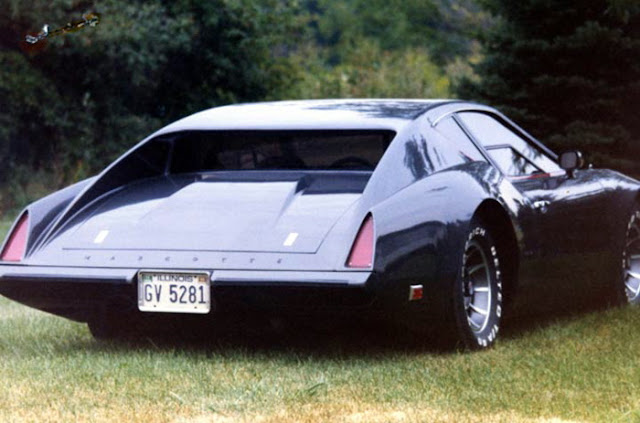 |
| The restored Darnval LM2, owned by Mr. Jean Noel Guerreau |
The Darnval story begins in Le Havre, France and was born of a partnership between car designer and engineer Vincent Mausset and the Lechère brothers, specialists in polyester resin plastic bathroom elements. Mausset brought the talent and the Lechères had the funds and ambition to make racecars and road cars. Together they enlisted Lenham Motors of Kent, England to manufacture the cars. The LM series of cars went through a couple of design iterations.
 |
The Darnval LM1
|
The prototype Darnval LM1 was a double-beamed, tubular steel chassis, equipped with the a-arm suspension of the Renault R8 at the front, as well as its rear crossmember. Its original engine was a Renault Gordini 1300 cc unit. The body was laminated to the chassis forming a partial monocoque, with only the doors and rear shell being separate. This first prototype was fully realized at Lenham Motors in Kent. It was exhibited at the 1972 Paris Motor Show, with a Chrysler Simca 2.0 liter motor.
 |
The Darnval LM1
|
The second example of the Darnval LM1, intended for production, utilized a central tub of aluminum and tubular steel with front and rear subframes for the engine and suspension components to be mounted on. Like the prototype, the plastic body elements were bonded to the chassis for added rigidity. These frames were entirely designed and built by Bernard Lagier, in Cambrai, in the workshops of F3 Narval single-seaters built by Croziers. The bodywork and assembly was done at Darnval in Le Havre. In keeping with the prototype, the "production" LM1 used Renault R8 parts and a 1600cc Gordini tuned motor.
 |
| The Darnval LM2 (image via News d'Anciennes) |
The Darnval LM2 was a subsequent development. It was a Lenham chassis modified by Darnval in Le Havre. It featured the addition of AG4 rivet aluminium panels on the chassis and the addition of forged wheel hub-carriers, replacing those of Spitfire used at the front by Lenham. The tubular chassis was done in box-section steel this time, with an aluminum tub. This made for a very rigid semi-monococque. The LM2 was originally equipped with a Renault Gordini 1600cc engine. The Darnval body was not bonded to chassis, unlike the LM1, but was fully removable for mechanical accessibility.
 |
The Darnval LM2, shown with front and rear bodywork removed
|
The LM2 was the last car delivered by Darnval as a company. That being said, Francis Lechere continued to finanace a few additional racecars in his time, some of which were referred to as "Darnvals".
In total, five Darnvals were officially produced by the company. There were four LM1 examples made and a single LM2. While they may be an obscure footnote in the history of French racers and sportscars, they were innovative and very handsome for their time.
Bonus Video of the restored LM2!
Sources:
 |
| The Darnval LM1 |
 |
| The Darnval LM1 |
 |
| The Darnval LM1 |
 |
| The Darnval LM1 Chassis |
 |
| The Darnval LM1 in profile |
 |
| The Darnval LM2 (image via News d'Anciennes) |
 |
| The Darnval LM2 (image via News d'Anciennes) |
 |
| The Darnval LM2 (image via News d'Anciennes) |
 |
| The Darnval LM2 (image via News d'Anciennes) |
 |
| The Darnval LM2 (image via News d'Anciennes) |
 |
| The Darnval LM2 (image via News d'Anciennes) |
 |
| The Darnval LM2 (image via YouTube) |
 |
| The Darnval LM2 (image via YouTube) |
 |
| The Darnval LM2 (image via YouTube) |
 |
| The Darnval LM2 (image via YouTube) |
 |
| The Darnval LM2 (image via YouTube) |
 |
| The Darnval LM2 (image via YouTube) |
 |
| The Darnval LM2 (image via YouTube) |
 |
| The Darnval LM2 (image via YouTube) |
 |
| The Darnval LM2 interior |
 |
| The Darnval LM2 - Engine and rear subframe |
 |
| The Darnval LM2 - head on |
 |
| The Darnval LM2 - Engine and rear subframe |
































Comments
Post a Comment